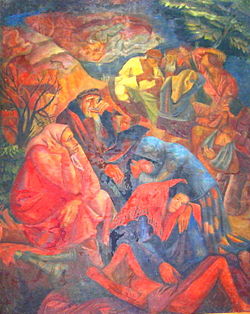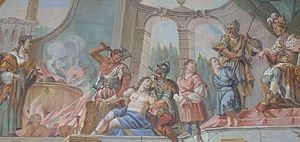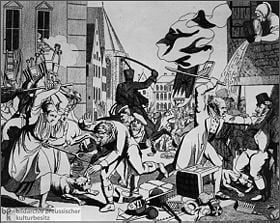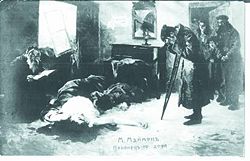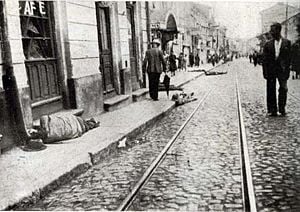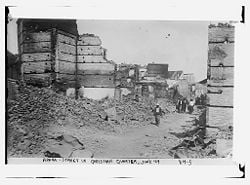Difference between revisions of "Pogrom" - New World Encyclopedia
m (→Ancient) |
m (Protected "Pogrom": 2copyedited [edit=sysop:move=sysop]) |
||
| (56 intermediate revisions by 5 users not shown) | |||
| Line 1: | Line 1: | ||
| − | + | {{Ebcompleted}}{{Images OK}}{{submitted}}{{approved}}{{copyedited}}{{2Copyedited}} | |
| + | [[Image:Pogrom.jpg|thumb|250px|''Pogrom,'' by Manuil Shechtman (1927) Kiev Museum of Ukrainian Art]] | ||
| − | [[ | + | A '''pogrom''' is a [[mob]] action targeting any specific ethnic or religious group, characterized by killing and destruction of their homes, businesses, and religious centers, often with the collusion of local, national, or religious authorities. The word can also refer to sanctioned violence against [[Jews]]. The word "pogrom" comes from the [[Russian]] погром, meaning a wreaking of havoc. It was first applied to anti-Jewish actions in imperial [[Russia]] during the nineteenth century and later applied retroactively to more ancient [[persecution]]s and also to other groups besides Jews. |
| − | + | Mob violence has been directed against the Jews for more than 2,000 years, motivated by both ethnic and religious hatred. Modern ''pogroms'' as such are dated from the nineteenth century, especially in [[Russia]] and [[Eastern Europe]]. In the late nineteenth and early twentieth centuries, a wave of particularly violent pogroms resulted in thousands of deaths and forced many Jews to leave Russia and [[Poland]]. The situation did not improve after the [[Russian Revolution]] of 1917, as religious Jews were the target of Soviet persecution and secular Jews in non-Soviet areas were blamed for sympathizing with the [[Bolsheviks]]. | |
| − | == | + | During the [[Nazi]] era, many Jews were victims of pogroms, beginning with the [[Kristallnacht]] riots of 1938 and continuing through the early years of [[World War II]], as some Eastern Europeans welcomed the Germans and blamed the Jews for the depredations of the [[Stalin]] regime. Later, the massacre of Jews was systematized by the Nazis through their infamous death camps, in which millions died. After the war, continued outbreaks of mob violence against Jews convinced most [[Holocaust]] survivors to leave Europe and seek refuge elsewhere, especially [[Israel]] and the [[United States]]. |
| + | |||
| + | As a more general term, "pogrom" can refer to any mob action by one ethnic or religious group against another. The examples of such atrocities unfortunately, are numerous. | ||
| + | |||
| + | ==Mob violence against Jews== | ||
| + | [[Image:Maccabeean-martyrs-closeup.jpg|thumb|300px|The [[martyr]]dom of the [[2 Maccabees|Maccabean brothers]]]] | ||
===Ancient=== | ===Ancient=== | ||
| − | Although the word pogrom is a modern one, riots directed against Jews go back to | + | Although the word ''pogrom'' is a modern one, riots directed against Jews go back to ancient times. Following the conquests of [[Alexander the Great]], Jewish tradition holds that Greek forces and their sympathizers committed widespread atrocities against Jewish civilians in the second century B.C.E., leading to the [[maccabees|Maccabean Revolt]] of 167. Similar anti-Jewish actions also reportedly took place in [[Africa]] under Greek rule, and there were antisemitic riots in [[Alexandria]] under the [[Roman Empire]] in 38 C.E. during the reign of [[Caligula]]. |
| − | Evidence of communal violence against [[Jew]]s | + | Evidence of communal violence against [[Jew]]s and [[early Christian]]s—who were seen as a Jewish sect—exists dating from the second century in [[Rome]]. These riots were generally precipitated by the Romans because Jews refused to accept Roman rule over [[Palestine]]. Once Christianity became the state religion of Rome, Christian mobs occasionally attacked Jews and destroyed [[synagogue]]s, and Jews generally fared much better in [[Muslim]] lands than the Christian Roman Empire. |
| − | ===Medieval=== | + | ===Medieval through early modern=== |
| + | Although the Muslims had been relatively tolerant toward the Jews, the 11th century saw several [[Islam|Muslim]] pogroms against Jews, such as those that occurred in [[Córdoba, Spain|Cordoba]] in 1011 and in [[Granada]] in 1066. In the [[1066 Granada massacre]], a Muslim mob crucified the Jewish [[vizier]] [[Joseph ibn Naghrela]] and massacred about 4,000 Jews. | ||
| − | + | Massive violent attacks against Jews by Christians dates back at least to the [[Crusades]], such as the pogroms of 1096 in [[France]] and [[Germany]], as well as the [[History of the Jews in England#Massacres at London and York (1189–1190)|massacres of Jews at London and York in 1189–1190]]. | |
| − | + | During the [[Black Plague]] of 1348, Jews were accused of responsibility and massacred in [[Chillon]], [[Basle]], [[Stuttgart]], [[Ulm]], [[Speyer]], [[Dresden]], [[Strasbourg]], and [[Mainz]]. A large number of the surviving Jews fled to [[Poland]], which welcomed Jews at the time. In [[Spain]] and [[Portugal]], meanwhile, violence against [[Marranos]] (Jewish converts to [[Christianity]] suspected of secret [[Judaism]]), sometimes instigated by Catholic authorities, was widespread leading up to the expulsion of the Jews from Spain and Portugal. | |
| − | + | Jews and Roman Catholics were both massacred during the [[Khmelnytsky Uprising]] of [[Ukrainian Cossacks]] in 1648–1654, as well as in the following century during the [[Koliyivshchyna]]. | |
| − | + | ==Modern pogroms== | |
| + | ===The Hep-hep riots=== | ||
| + | [[Image:Hep-hep riots.jpg|280px|thumb|[[Hep-Hep riots]] in Frankfurt, 1819. On the left, two peasant women are assaulting a Jewish man with pitchfork and broom. On the right, a man in tails holds another Jewish man by the throat and is about to club him with a truncheon.]] | ||
| + | The Hep-Hep riots were early nineteenth century pogroms against [[German Jews]]. The antisemitic communal violence began on August 2, 1819, in Würzburg and soon reached as far as regions of [[Denmark]], [[Poland]], [[Latvia]], and [[Bohemia]]. Many Jews were killed and much Jewish property was destroyed. In some towns, the police appeared too late or stood by idly while the mob raged through the streets. | ||
===Russian Empire=== | ===Russian Empire=== | ||
| − | [[ | + | The first pogrom named as such may have been the 1821 anti-Jewish riots in [[Odessa]] (modern [[Ukraine]]) after the death of the [[Eastern Orthodox Church|Greek Orthodox]] patriarch in [[Istanbul]], in which 14 Jews were killed. However, a larger pogrom occurred in the same city in 1859, when Greek sailors from ships in the harbor, joined by local Greek residents, attacked the Jewish community of Odessa on [[Easter]], blaming them as "Christ-killers." Further pogroms occurred here in 1871, 1881, and 1886. |
| − | |||
| − | The term | + | The term "pogrom" became commonly used in English after a large-scale wave of anti-Jewish riots swept through southwestern [[Imperial Russia]] in 1881–1884. The trigger for these pogroms was the [[Alexander II of Russia#Assassination|assassination of Tsar Alexander II]], for which some in the media and the Orthodox churches blamed "the Jews." Local economic conditions are thought to have contributed significantly to the rioting as well. However, one of the assassins, [[Gesya Gelfman]], was indeed Jewish. The fact that the other assassins were all Christians had little impact on the spread of the rumor of Jewish responsibility. |
| − | The | + | [[Image:Ekaterinoslav1905.jpg|thumb|250px|left|The victims, mostly Jewish children, of a 1905 pogrom in Yekaterinoslav (today's [[Dnipropetrovsk]]), south of Ukraine's capital of [[Kiev]].]] |
| − | The | + | An even bloodier wave of pogroms broke out in Russian and Eastern Europe in 1903–1906, leaving thousands of Jews dead and many more wounded, as the Jews took to arms to defend their families and property from the attackers. The 1905 pogrom against the Jews of [[Odessa]] was the most serious pogrom of the period, with reports of up to 2,500 Jews killed in that city alone. Historians believe that some of the pogroms had been organized or supported by the [[Tsar]]ist Russian [[secret police]], the [[Okhrana]]. |
| − | The | + | The pogroms of the 1880s through 1905 caused a worldwide outcry and propelled mass Jewish emigration. Two million Jews fled the Russian Empire between 1880 and 1914, with many going to the [[United Kingdom]] and the [[United States]]. In reaction to the pogroms and other oppressions of the Tsarist period, Jews increasingly became politically active. Jewish participation in the [[General Jewish Labor Union]], colloquially known as The Bund, and in the [[Bolshevik]] movements, was directly influenced by the pogroms, as was the rise of [[Zionism]], especially by [[Russian Jews]]. |
| − | + | [[Image:Maimon Home.jpg|thumb|250px|right|''Home at last'' by [[Moshe Maimon]] depicts a young Jewish man mourning the death of a relatives killed in a pogrom.]] | |
| − | [[ | + | Many pogroms also accompanied the [[Revolution of 1917]], which saw religion as an implacable enemy and targeted [[Hasidic Judaism]] as particularly resistant to the Soviet program. The ensuing [[Russian Civil War]] also found Jewish communities victimized by anti-Soviet forces who blamed the Jews—Marx was the son of a Jewish convert to Christianity—for [[Communism]]. In all, an estimated 70,000 to 250,000 Jewish civilians were killed in the atrocities throughout the former [[Russian Empire]]; the number of Jewish orphans exceeded 300,000. |
| − | |||
| − | |||
| − | |||
| − | |||
| − | |||
| − | |||
| − | |||
===Outside Russia=== | ===Outside Russia=== | ||
| − | Pogroms spread throughout Central and Eastern Europe | + | Pogroms also spread throughout Central and Eastern Europe, and anti-Jewish riots also broke out elsewhere in the world: |
| − | * During the [[Greek War of Independence]], thousands of Jews were [[Massacres during the Greek Revolution|massacred by the Greeks]] to the point of complete elimination | + | * During the [[Greek War of Independence]] (1821–1829), thousands of Jews were [[Massacres during the Greek Revolution|massacred by the Greeks]] to the point of complete elimination |
| − | + | * In the Americas, there was a pogrom in [[Argentina]] in 1919, during the [[Tragic Week (Argentina, 1919)|Tragic Week]] | |
| − | * In the Americas, there was a pogrom in [[Argentina]] in 1919, during the [[Tragic Week (Argentina, 1919)|Tragic Week]] [ | + | * In 1927, there were pogroms in [[Oradea]] ([[Romania]]) |
| − | + | In the Arab world, pogroms played a key role in the massive emigration of Jews from Arab countries to Israel during rising tensions and violence in [[Palestine]] as Jews tried to secure a homeland there. | |
| − | In the Arab world, | + | * The [[Farhud]] pogrom in [[Iraq]] killed between 200 and 400 Jews of Baghdad, on June 1-2, 1941 |
| − | + | * In 1945, anti-Jewish rioters in [[Tripoli]], Libya killed 140 Jews | |
| − | * The [[Farhud]] pogrom in [[Iraq]] killed between 200 and 400 Jews | ||
| − | |||
| − | |||
===During the Holocaust=== | ===During the Holocaust=== | ||
| − | Pogroms were also encouraged by the Nazis, especially early in the war before the | + | [[Image:פוגרום יאשי 4.jpg|thumb|300px|Jewish bodies litter the street in the aftermath the the pogrom in Iaşi, Romania in 1941.]] |
| − | + | Pogroms were also encouraged by the Nazis, especially early in the war before the more systematic mass killings began. The first of these pogroms was ''[[Kristallnacht]]'' in Nazi [[Germany]], often called ''[[Pogromnacht]],'' in which Jewish homes and businesses were destroyed, up to 200 Jews were killed, and some 30,000 Jewish men and boys were arrested and sent to [[concentration camp]]s. | |
| − | |||
| − | |||
| − | |||
| − | In | + | A number of deadly pogroms occurred during the [[Holocaust]] at the hands of non-Germans. Throughout Eastern Europe, elements of the local population which had suffered under the [[Soviet Union]] welcomed the Germans as liberators and turned against their Jewish neighbors, resulting in thousands of deaths. In the [[Jedwabne pogrom]] of 1941, Polish citizens killed between 400 and 1,600 Jews with German assistance. In the city of [[Lwów]] (today Lviv), Ukrainian nationalists reportedly organized two large pogroms in June-July 1941 in which around 6,000 Jews were murdered, in apparent retribution for the alleged collaboration of some Jews with the previous Soviet regime. In [[Lithuania]], Lithuanian nationalists engaged in anti-Jewish pogroms on June 25-26, 1941, after the Nazi troops had entered the city, killing about 3,800 Jews and burning [[synagogue]]s and Jewish shops. A similar massacre was reported in [[Minsk]] in today's [[Belarus]], where a mass grave of some 5,000 Jews was discovered after the war. Perhaps the deadliest of these Holocaust-era pogroms was the [[Iaşi pogrom]] in Romania, in which as many as 13,266 Jews were killed by Romanian citizens, police, and military officials. |
| − | |||
===After World War II=== | ===After World War II=== | ||
| − | Even after the end of World War II, there were still a few pogroms in [[Poland]], such as the [[Kraków pogrom]] on August 11, 1945 | + | Even after the end of World War II, there were still a few pogroms in [[Poland]], such as the [[Kraków pogrom]] on August 11, 1945, and the [[Kielce pogrom]] of 1946, in which 37 Jews were killed. Deadly anti-Jewish riots also broke out in several other Polish cities. Until today, the debate in Poland continues as to whether the murderers in Kielce were leftists or rightists, but the event was a turning point which convinced many [[Holocaust survivors]] that they had no future in Poland and Eastern Europe. |
| − | |||
| − | Until today, the debate in Poland continues as to whether the murderers in Kielce were leftists or rightists | ||
| − | |||
| − | |||
| − | |||
| − | |||
| − | |||
| − | |||
| − | + | ==Other examples== | |
| + | [[Image:AdanaChristianQuarter.jpg|right|thumb|250px|A [[Adana massacre|1909 pogrom]] of Armenians in the Ottoman Empire claimed tens of thousands of lives, as Armenian and Christian property was burned en masse.]] | ||
| + | Other ethnic and religious groups have suffered from similar targeted riots at various times and in different countries, and the term is commonly used in the general context of riots against various ethnic groups. For example, both [[Jew]]s and [[Muslim]]s (called [[Moriscos]]) suffered pogrom-like attacks by [[Christians]] in the wake of the Catholic ''[[reconquista]]'' of the [[Iberian peninsula]] in the late medieval period. In Eastern Europe, ethnic violence has been the rule rather than the exception through much of modern history. | ||
| − | + | In the view of some historians, the mass violence and murder targeting [[African Americans]] during the [[New York Draft Riots]] of 1863 can be defined as pogroms, though the word had not yet entered the English language at the time. The same could be said of the 1871 mob violence of Latinos against Chinese in [[Los Angeles, California|Los Angeles]], [[California]], which resulted in at least 19 deaths. | |
| − | |||
| − | In | + | In 1909, a campaign against Christian Armenians in the [[Ottoman Empire]] claimed tens of thousands of lives, and Armenian and Christian property was burned ''en masse,'' most notoriously in the [[Adana massacre]]. Many [[Koreans]] in Japan were killed in the wake of the [[1923 Great Kantō earthquake]] in [[Tokyo]], after newspapers printed articles saying Koreans were systematically poisoning wells. The treatment of Palestinians by Israelis during Israel's struggle for independence in 1948 has also sometimes been called a pogrom. |
| − | |||
| − | + | In the 1955 [[Istanbul Pogrom]], ethnic [[Greeks]] were attacked and overwhelmed by ethnic [[Turkish people|Turkish]] mobs. In the years leading up to the [[Nigerian Civil War|Biafran War]], ethnic [[Igbo people|Igbos]] and others from southeastern [[Nigeria]] were victims of targeted attacks. | |
| − | |||
| − | [[ | + | [[Sikhs]] have also experienced pogroms in [[India]], most notably in November 1984 after India's Prime Minister [[Indira Gandhi]] was assassinated by two of her Sikh guards. Other examples include the pogroms against ethnic [[Armenians]] in [[Sumgait pogrom|Sumgait]] in 1988 and in [[Pogrom of Armenians in Baku|Baku]], in 1990, both of which occurred in [[Azerbaijan]]. The [[Jakarta Riots of May 1998]] were pogroms targeted against ethnic Chinese in Indonesia. In 1999, the [[ethnic cleansing]] campaigns in various areas of the former [[Yugoslavia]] may also be considered as pogroms. Another notorious [[Religious violence in India|pogrom in India]] happened in the state of Gujarat in March 2002, when [[Muslims]] were systematically targeted and killed. Estimates of the numbers killed range from several hundred to 2,000. A pogrom is ongoing in Darfur, [[Sudan]], originally thought to be against [[Christian]]s and [[Animist]]s by the Muslim majority, but now apparently of Arab against non-Arab and possibly a tribal/political pogrom. |
| − | + | Unfortunately, the examples of ethnic violence of one population against another in recent times have been so numerous that they cannot be fully detailed here. | |
| − | |||
| − | |||
| − | |||
| − | |||
| − | |||
| − | |||
| − | |||
| − | |||
| − | |||
| − | |||
==See also== | ==See also== | ||
* [[Anti-Semitism]] | * [[Anti-Semitism]] | ||
| − | |||
* [[Ethnic cleansing]] | * [[Ethnic cleansing]] | ||
| − | + | * [[Anti-Judaism]] | |
| − | |||
| − | |||
| − | |||
| − | |||
| − | |||
| − | |||
| − | |||
| − | |||
| − | * [[Anti- | ||
| − | |||
| − | |||
| − | |||
| − | |||
| − | |||
==References== | ==References== | ||
| − | + | * Aronson, Irwin Michael. ''Troubled Waters: The Origins of the 1881 Anti-Jewish Pogroms in Russia''. Pittsburgh, PA: University of Pittsburgh Press, 1990. ISBN 9780822936565. | |
| − | + | * Brass, Paul R. ''Riots and Pogroms''. New York: New York University Press, 1996. ISBN 9780814712825. | |
| − | + | * Gitelman, Zvi. ''Anti-Semitism in the USSR: Sources, Types, Consequences.'' Institute for Jewish Policy Planning & Research of the Synagogue Council of America, 1974. | |
| − | {{ | + | * Klarfeld, Simon. ''Anti-Semitism in the USSR.'' London: Talis Books, 1990. ISBN 9781873348000. |
| − | + | * Klier, John, and Shlomo Lambroza. ''Pogroms: Anti-Jewish Violence in Modern Russian History''. Cambridge: Cambridge University Press, 1992. ISBN 9780521405324. | |
| − | + | * Lambroza, Shlomo. ''The Tsarist Government and the Pogroms of 1903-06''. Baltimore, MD: Johns Hopkins University Press, 1987. {{OCLC|47855557}}. | |
| + | * Vryonis, Speros. ''The Mechanism of Catastrophe: The Turkish Pogrom of September 6-7, 1955, and the Destruction of the Greek Community of Istanbul''. New York, NY: Greekworks.com, 2005. ISBN 9780974766034. | ||
[[Category:history and biography]] | [[Category:history and biography]] | ||
Latest revision as of 16:04, 26 December 2008
A pogrom is a mob action targeting any specific ethnic or religious group, characterized by killing and destruction of their homes, businesses, and religious centers, often with the collusion of local, national, or religious authorities. The word can also refer to sanctioned violence against Jews. The word "pogrom" comes from the Russian погром, meaning a wreaking of havoc. It was first applied to anti-Jewish actions in imperial Russia during the nineteenth century and later applied retroactively to more ancient persecutions and also to other groups besides Jews.
Mob violence has been directed against the Jews for more than 2,000 years, motivated by both ethnic and religious hatred. Modern pogroms as such are dated from the nineteenth century, especially in Russia and Eastern Europe. In the late nineteenth and early twentieth centuries, a wave of particularly violent pogroms resulted in thousands of deaths and forced many Jews to leave Russia and Poland. The situation did not improve after the Russian Revolution of 1917, as religious Jews were the target of Soviet persecution and secular Jews in non-Soviet areas were blamed for sympathizing with the Bolsheviks.
During the Nazi era, many Jews were victims of pogroms, beginning with the Kristallnacht riots of 1938 and continuing through the early years of World War II, as some Eastern Europeans welcomed the Germans and blamed the Jews for the depredations of the Stalin regime. Later, the massacre of Jews was systematized by the Nazis through their infamous death camps, in which millions died. After the war, continued outbreaks of mob violence against Jews convinced most Holocaust survivors to leave Europe and seek refuge elsewhere, especially Israel and the United States.
As a more general term, "pogrom" can refer to any mob action by one ethnic or religious group against another. The examples of such atrocities unfortunately, are numerous.
Mob violence against Jews
Ancient
Although the word pogrom is a modern one, riots directed against Jews go back to ancient times. Following the conquests of Alexander the Great, Jewish tradition holds that Greek forces and their sympathizers committed widespread atrocities against Jewish civilians in the second century B.C.E., leading to the Maccabean Revolt of 167. Similar anti-Jewish actions also reportedly took place in Africa under Greek rule, and there were antisemitic riots in Alexandria under the Roman Empire in 38 C.E. during the reign of Caligula.
Evidence of communal violence against Jews and early Christians—who were seen as a Jewish sect—exists dating from the second century in Rome. These riots were generally precipitated by the Romans because Jews refused to accept Roman rule over Palestine. Once Christianity became the state religion of Rome, Christian mobs occasionally attacked Jews and destroyed synagogues, and Jews generally fared much better in Muslim lands than the Christian Roman Empire.
Medieval through early modern
Although the Muslims had been relatively tolerant toward the Jews, the 11th century saw several Muslim pogroms against Jews, such as those that occurred in Cordoba in 1011 and in Granada in 1066. In the 1066 Granada massacre, a Muslim mob crucified the Jewish vizier Joseph ibn Naghrela and massacred about 4,000 Jews.
Massive violent attacks against Jews by Christians dates back at least to the Crusades, such as the pogroms of 1096 in France and Germany, as well as the massacres of Jews at London and York in 1189–1190.
During the Black Plague of 1348, Jews were accused of responsibility and massacred in Chillon, Basle, Stuttgart, Ulm, Speyer, Dresden, Strasbourg, and Mainz. A large number of the surviving Jews fled to Poland, which welcomed Jews at the time. In Spain and Portugal, meanwhile, violence against Marranos (Jewish converts to Christianity suspected of secret Judaism), sometimes instigated by Catholic authorities, was widespread leading up to the expulsion of the Jews from Spain and Portugal.
Jews and Roman Catholics were both massacred during the Khmelnytsky Uprising of Ukrainian Cossacks in 1648–1654, as well as in the following century during the Koliyivshchyna.
Modern pogroms
The Hep-hep riots
The Hep-Hep riots were early nineteenth century pogroms against German Jews. The antisemitic communal violence began on August 2, 1819, in Würzburg and soon reached as far as regions of Denmark, Poland, Latvia, and Bohemia. Many Jews were killed and much Jewish property was destroyed. In some towns, the police appeared too late or stood by idly while the mob raged through the streets.
Russian Empire
The first pogrom named as such may have been the 1821 anti-Jewish riots in Odessa (modern Ukraine) after the death of the Greek Orthodox patriarch in Istanbul, in which 14 Jews were killed. However, a larger pogrom occurred in the same city in 1859, when Greek sailors from ships in the harbor, joined by local Greek residents, attacked the Jewish community of Odessa on Easter, blaming them as "Christ-killers." Further pogroms occurred here in 1871, 1881, and 1886.
The term "pogrom" became commonly used in English after a large-scale wave of anti-Jewish riots swept through southwestern Imperial Russia in 1881–1884. The trigger for these pogroms was the assassination of Tsar Alexander II, for which some in the media and the Orthodox churches blamed "the Jews." Local economic conditions are thought to have contributed significantly to the rioting as well. However, one of the assassins, Gesya Gelfman, was indeed Jewish. The fact that the other assassins were all Christians had little impact on the spread of the rumor of Jewish responsibility.
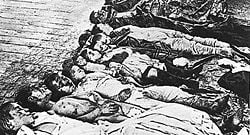
An even bloodier wave of pogroms broke out in Russian and Eastern Europe in 1903–1906, leaving thousands of Jews dead and many more wounded, as the Jews took to arms to defend their families and property from the attackers. The 1905 pogrom against the Jews of Odessa was the most serious pogrom of the period, with reports of up to 2,500 Jews killed in that city alone. Historians believe that some of the pogroms had been organized or supported by the Tsarist Russian secret police, the Okhrana.
The pogroms of the 1880s through 1905 caused a worldwide outcry and propelled mass Jewish emigration. Two million Jews fled the Russian Empire between 1880 and 1914, with many going to the United Kingdom and the United States. In reaction to the pogroms and other oppressions of the Tsarist period, Jews increasingly became politically active. Jewish participation in the General Jewish Labor Union, colloquially known as The Bund, and in the Bolshevik movements, was directly influenced by the pogroms, as was the rise of Zionism, especially by Russian Jews.
Many pogroms also accompanied the Revolution of 1917, which saw religion as an implacable enemy and targeted Hasidic Judaism as particularly resistant to the Soviet program. The ensuing Russian Civil War also found Jewish communities victimized by anti-Soviet forces who blamed the Jews—Marx was the son of a Jewish convert to Christianity—for Communism. In all, an estimated 70,000 to 250,000 Jewish civilians were killed in the atrocities throughout the former Russian Empire; the number of Jewish orphans exceeded 300,000.
Outside Russia
Pogroms also spread throughout Central and Eastern Europe, and anti-Jewish riots also broke out elsewhere in the world:
- During the Greek War of Independence (1821–1829), thousands of Jews were massacred by the Greeks to the point of complete elimination
- In the Americas, there was a pogrom in Argentina in 1919, during the Tragic Week
- In 1927, there were pogroms in Oradea (Romania)
In the Arab world, pogroms played a key role in the massive emigration of Jews from Arab countries to Israel during rising tensions and violence in Palestine as Jews tried to secure a homeland there.
- The Farhud pogrom in Iraq killed between 200 and 400 Jews of Baghdad, on June 1-2, 1941
- In 1945, anti-Jewish rioters in Tripoli, Libya killed 140 Jews
During the Holocaust
Pogroms were also encouraged by the Nazis, especially early in the war before the more systematic mass killings began. The first of these pogroms was Kristallnacht in Nazi Germany, often called Pogromnacht, in which Jewish homes and businesses were destroyed, up to 200 Jews were killed, and some 30,000 Jewish men and boys were arrested and sent to concentration camps.
A number of deadly pogroms occurred during the Holocaust at the hands of non-Germans. Throughout Eastern Europe, elements of the local population which had suffered under the Soviet Union welcomed the Germans as liberators and turned against their Jewish neighbors, resulting in thousands of deaths. In the Jedwabne pogrom of 1941, Polish citizens killed between 400 and 1,600 Jews with German assistance. In the city of Lwów (today Lviv), Ukrainian nationalists reportedly organized two large pogroms in June-July 1941 in which around 6,000 Jews were murdered, in apparent retribution for the alleged collaboration of some Jews with the previous Soviet regime. In Lithuania, Lithuanian nationalists engaged in anti-Jewish pogroms on June 25-26, 1941, after the Nazi troops had entered the city, killing about 3,800 Jews and burning synagogues and Jewish shops. A similar massacre was reported in Minsk in today's Belarus, where a mass grave of some 5,000 Jews was discovered after the war. Perhaps the deadliest of these Holocaust-era pogroms was the Iaşi pogrom in Romania, in which as many as 13,266 Jews were killed by Romanian citizens, police, and military officials.
After World War II
Even after the end of World War II, there were still a few pogroms in Poland, such as the Kraków pogrom on August 11, 1945, and the Kielce pogrom of 1946, in which 37 Jews were killed. Deadly anti-Jewish riots also broke out in several other Polish cities. Until today, the debate in Poland continues as to whether the murderers in Kielce were leftists or rightists, but the event was a turning point which convinced many Holocaust survivors that they had no future in Poland and Eastern Europe.
Other examples
Other ethnic and religious groups have suffered from similar targeted riots at various times and in different countries, and the term is commonly used in the general context of riots against various ethnic groups. For example, both Jews and Muslims (called Moriscos) suffered pogrom-like attacks by Christians in the wake of the Catholic reconquista of the Iberian peninsula in the late medieval period. In Eastern Europe, ethnic violence has been the rule rather than the exception through much of modern history.
In the view of some historians, the mass violence and murder targeting African Americans during the New York Draft Riots of 1863 can be defined as pogroms, though the word had not yet entered the English language at the time. The same could be said of the 1871 mob violence of Latinos against Chinese in Los Angeles, California, which resulted in at least 19 deaths.
In 1909, a campaign against Christian Armenians in the Ottoman Empire claimed tens of thousands of lives, and Armenian and Christian property was burned en masse, most notoriously in the Adana massacre. Many Koreans in Japan were killed in the wake of the 1923 Great Kantō earthquake in Tokyo, after newspapers printed articles saying Koreans were systematically poisoning wells. The treatment of Palestinians by Israelis during Israel's struggle for independence in 1948 has also sometimes been called a pogrom.
In the 1955 Istanbul Pogrom, ethnic Greeks were attacked and overwhelmed by ethnic Turkish mobs. In the years leading up to the Biafran War, ethnic Igbos and others from southeastern Nigeria were victims of targeted attacks.
Sikhs have also experienced pogroms in India, most notably in November 1984 after India's Prime Minister Indira Gandhi was assassinated by two of her Sikh guards. Other examples include the pogroms against ethnic Armenians in Sumgait in 1988 and in Baku, in 1990, both of which occurred in Azerbaijan. The Jakarta Riots of May 1998 were pogroms targeted against ethnic Chinese in Indonesia. In 1999, the ethnic cleansing campaigns in various areas of the former Yugoslavia may also be considered as pogroms. Another notorious pogrom in India happened in the state of Gujarat in March 2002, when Muslims were systematically targeted and killed. Estimates of the numbers killed range from several hundred to 2,000. A pogrom is ongoing in Darfur, Sudan, originally thought to be against Christians and Animists by the Muslim majority, but now apparently of Arab against non-Arab and possibly a tribal/political pogrom.
Unfortunately, the examples of ethnic violence of one population against another in recent times have been so numerous that they cannot be fully detailed here.
See also
- Anti-Semitism
- Ethnic cleansing
- Anti-Judaism
ReferencesISBN links support NWE through referral fees
- Aronson, Irwin Michael. Troubled Waters: The Origins of the 1881 Anti-Jewish Pogroms in Russia. Pittsburgh, PA: University of Pittsburgh Press, 1990. ISBN 9780822936565.
- Brass, Paul R. Riots and Pogroms. New York: New York University Press, 1996. ISBN 9780814712825.
- Gitelman, Zvi. Anti-Semitism in the USSR: Sources, Types, Consequences. Institute for Jewish Policy Planning & Research of the Synagogue Council of America, 1974.
- Klarfeld, Simon. Anti-Semitism in the USSR. London: Talis Books, 1990. ISBN 9781873348000.
- Klier, John, and Shlomo Lambroza. Pogroms: Anti-Jewish Violence in Modern Russian History. Cambridge: Cambridge University Press, 1992. ISBN 9780521405324.
- Lambroza, Shlomo. The Tsarist Government and the Pogroms of 1903-06. Baltimore, MD: Johns Hopkins University Press, 1987. OCLC 47855557.
- Vryonis, Speros. The Mechanism of Catastrophe: The Turkish Pogrom of September 6-7, 1955, and the Destruction of the Greek Community of Istanbul. New York, NY: Greekworks.com, 2005. ISBN 9780974766034.
Credits
New World Encyclopedia writers and editors rewrote and completed the Wikipedia article in accordance with New World Encyclopedia standards. This article abides by terms of the Creative Commons CC-by-sa 3.0 License (CC-by-sa), which may be used and disseminated with proper attribution. Credit is due under the terms of this license that can reference both the New World Encyclopedia contributors and the selfless volunteer contributors of the Wikimedia Foundation. To cite this article click here for a list of acceptable citing formats.The history of earlier contributions by wikipedians is accessible to researchers here:
The history of this article since it was imported to New World Encyclopedia:
Note: Some restrictions may apply to use of individual images which are separately licensed.
